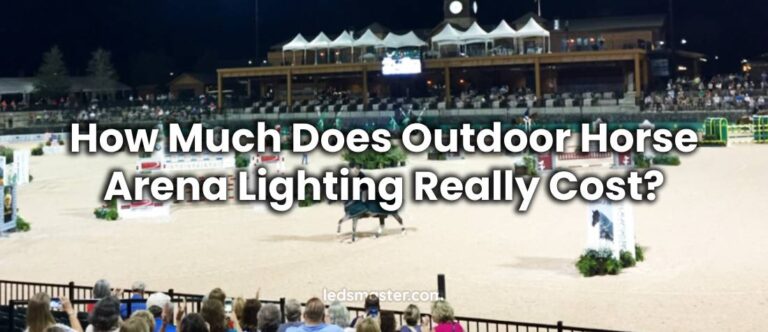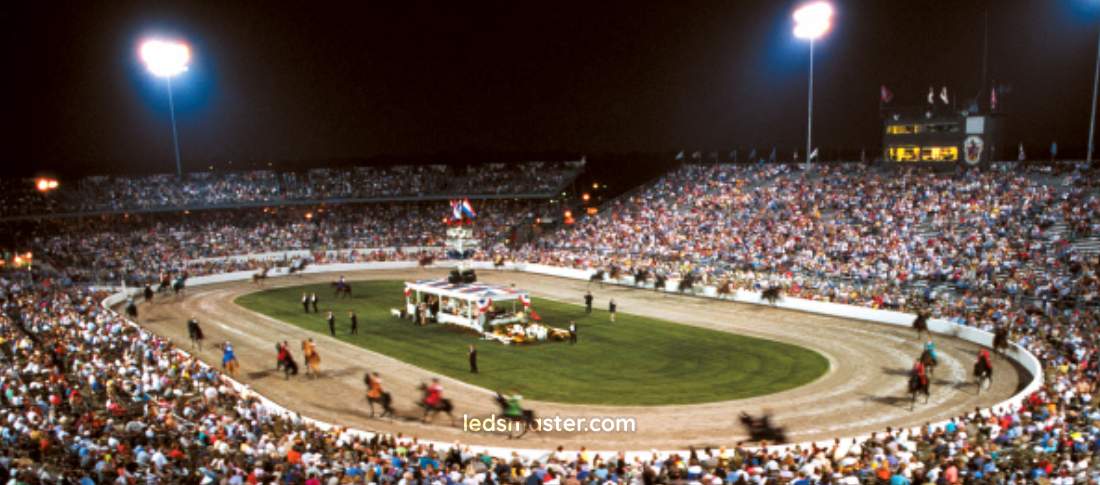
Whether you’re installing a new system or upgrading an existing one, understanding the costs involved can help you make the best decision for your arena. Let’s explore the various factors that influence the overall price of outdoor horse arena lighting and what to expect in terms of investment.
Get your complimentary lighting design today
Properly designed lighting can enhance both the rider’s and the horse’s experience, providing adequate visibility without causing glare or shadows that may disturb the performance. However, understanding the cost involved in lighting an outdoor horse arena can be complex due to various influencing factors.
Table of Contents
ToggleSeveral elements contribute to the overall cost of installing lighting in an outdoor horse arena. These factors range from the type of lighting technology to the size of the arena itself, and each aspect has an impact on the final price.
The larger the arena, the more lighting fixtures will be required to ensure sufficient illumination. Larger arenas require more lights spaced at appropriate intervals to avoid dark spots, while smaller arenas may require fewer fixtures. The number of lights directly affects the cost, as each additional fixture adds to the overall budget.

LED lights, for instance, are known for their energy efficiency and long lifespan, which can make them a popular choice despite their higher upfront cost. On the other hand, traditional metal halide or halogen lights may have lower initial costs but require more frequent maintenance and energy consumption, leading to higher long-term expenses.
The height at which the lights are mounted and the placement of poles around the arena can impact both the cost and effectiveness of the lighting system. Taller poles may require more powerful lighting fixtures to ensure the light reaches the arena floor adequately, while lower poles may need additional fixtures to cover the same area. The material and installation of the poles themselves also contribute to the overall cost.
Installing outdoor arena lighting often requires upgrades to the existing electrical infrastructure. The distance of the arena from the main power source, the availability of existing wiring, and the need for additional electrical work all add to the cost. In some cases, additional transformers or circuit breakers may be necessary to support the new lighting system.
The ongoing cost of operating the lights should also be considered. LED lights, while more expensive initially, tend to consume less electricity, leading to lower energy bills. Conversely, traditional lighting options such as metal halide or halogen lights may have higher energy consumption, increasing the overall operational cost. The choice of lighting directly influences not only the installation cost but also the long-term energy expenses.
Outdoor horse arenas are exposed to various weather conditions, which can affect the durability and longevity of the lighting fixtures. Lighting systems designed to withstand harsh weather conditions, such as wind, rain, and temperature fluctuations, tend to be more expensive due to their robust design. The cost of maintenance may also increase if the lighting system is not adequately protected against environmental wear and tear.
The complexity of the installation process can greatly influence the cost. Factors such as the need for trenching to lay electrical cables, the difficulty of pole placement, and the requirement for specialized equipment all affect the labor costs. Professional installation services may vary in price depending on the region and the specific requirements of the project.
In some areas, there may be zoning regulations or permitting requirements that need to be addressed before installing outdoor lighting. These regulations could impact the type and number of lights that can be installed, as well as where they are placed. The cost of obtaining necessary permits or adhering to specific lighting standards can add to the overall expense of the project.
Understanding the individual components that contribute to the overall cost of outdoor horse arena lighting helps to provide a clearer picture of what to expect. The cost can be broken down into several key areas, including lighting fixtures, poles, electrical work, and ongoing energy consumption.
LED lights, due to their energy efficiency and long lifespan, generally have a higher initial cost but offer savings in the long run. The price of LED fixtures can range from a few hundred dollars per fixture to several thousand, depending on the wattage and specifications. Traditional metal halide lights are typically less expensive upfront but may require replacement more frequently due to their shorter lifespan.
Steel poles, which are commonly used for their durability, tend to be more expensive than aluminum or wooden alternatives. The installation of the poles, including any necessary concrete footings, also adds to the cost. In general, the taller the pole, the higher the overall cost, as more substantial materials and additional labor are required.
The cost of electrical work can vary based on the existing infrastructure at the site. If the arena is located far from the main power source, additional cabling and trenching may be necessary to provide electricity to the lights. Electrical contractors typically charge for both materials and labor, with costs increasing if new transformers or circuit breakers are needed to support the lighting system.
The ongoing energy cost depends on the type of lighting fixtures used and how often the arena lights are in operation. LED lights are known for their lower energy consumption, which can result in significant savings over time. Metal halide and halogen lights, while less expensive initially, typically consume more electricity and may lead to higher utility bills. Calculating the energy consumption based on the wattage of the fixtures and the hours of operation can give a clearer understanding of the long-term costs.
The maintenance and replacement of lighting fixtures should also be considered in the overall cost. LED lights typically have a longer lifespan, reducing the frequency of replacement and maintenance. However, traditional lighting fixtures may require more frequent attention, particularly if they are exposed to harsh environmental conditions. The cost of replacement bulbs, maintenance labor, and any necessary repairs can add up over time.

While the cost of outdoor horse arena lighting can vary widely depending on the factors discussed above, providing some example estimates can help to illustrate the potential range of expenses. These estimates are based on a medium-sized outdoor arena and assume professional installation and standard equipment.
| Arena Size | Dimensions | Cost Range | Details |
|---|---|---|---|
| Small Outdoor Arena | 60 ft x 100 ft | $5,000 – $10,000 | Includes LED fixtures, poles, electrical work, and installation. Low ongoing energy costs. |
| Medium Outdoor Arena | 100 ft x 200 ft | $10,000 – $25,000 | Requires more fixtures and poles. LED lighting offers long-term savings; metal halide may reduce initial cost but increase operational costs. |
| Large Outdoor Arena | 200 ft x 300 ft+ | $25,000 – $50,000+ | Higher costs due to more powerful fixtures, additional poles, and potential infrastructure upgrades. Choices in lighting technology affect both initial and ongoing expenses. |
For a small outdoor horse arena, typically measuring around 60 feet by 100 feet, the cost of lighting may range from $5,000 to $10,000. This estimate includes the cost of LED fixtures, poles, electrical work, and installation labor. The ongoing energy costs for LED lighting would be relatively low, making this a cost-effective option for small arenas.
A medium-sized outdoor arena, measuring approximately 100 feet by 200 feet, would require more lighting fixtures and poles, increasing the overall cost. In this case, the total cost may range from $10,000 to $25,000, depending on the type of lighting used and the complexity of the installation. LED lighting would provide long-term energy savings, while metal halide fixtures may lower the initial cost but increase operational expenses over time.
For a large outdoor horse arena, measuring 200 feet by 300 feet or more, the cost of lighting can range from $25,000 to $50,000 or more. Larger arenas require more powerful lighting fixtures and additional poles to ensure adequate coverage. The cost of electrical work may also be higher, particularly if significant upgrades to the existing infrastructure are needed. The choice of lighting technology plays a significant role in determining both the initial cost and long-term expenses.
The energy cost associated with operating the lights can vary significantly depending on the type of fixtures and the hours of use. For example, a medium-sized arena with LED lighting may have an energy cost of around $500 to $1,000 per year, while an arena using metal halide fixtures could see annual energy costs of $1,500 to $3,000 or more. Over time, the savings associated with energy-efficient lighting can help to offset the higher initial cost of LED fixtures.
The lifespan of the lighting fixtures should also be considered when estimating the overall cost. LED lights generally have a lifespan of 50,000 to 100,000 hours, reducing the need for frequent replacements. In contrast, metal halide fixtures may need to be replaced every 10,000 to 20,000 hours, leading to higher maintenance costs over time. The cost of replacement bulbs and labor should be factored into the overall budget for maintaining the arena lighting system.
When planning the installation of outdoor horse arena lighting, a clear understanding of the factors influencing the cost can help ensure a successful project. Whether choosing LED lights for their energy efficiency and long lifespan or opting for traditional metal halide fixtures for a lower initial cost, the key is to balance the upfront investment with the long-term operating expenses. By considering the size of the arena, the type of lighting fixtures, and the associated electrical and maintenance costs, it becomes possible to design a lighting system that meets both functional and financial goals.